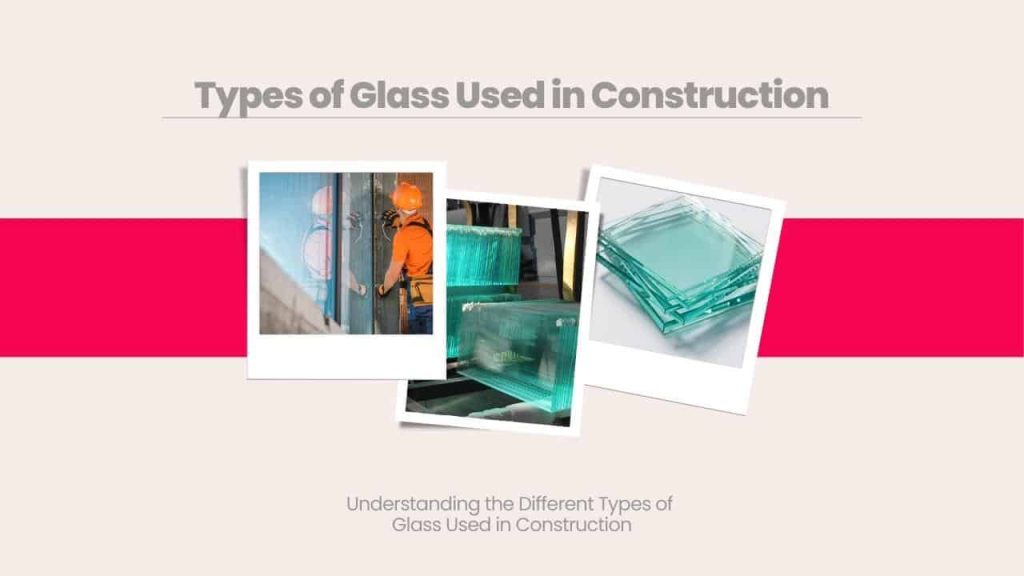Work Hours
Monday to Friday: 7AM - 7PM
Weekend: 10AM - 5PM
Types of Glass Used in Construction

Glass is an essential material used in modern construction with a wide range of applications in residential, commercial, and industrial projects. However, not all glass is equal, and understanding the different types of glass used in construction is crucial to ensure a building’s safety, durability, and aesthetic appeal. The world of glass is diverse and complex, with traditional annealed glass and energy-efficient low-e coatings being just a few examples. This blog aims to explore the various types of glass commonly used in construction and discuss their unique properties, benefits, and limitations. Whether you are a homeowner, architect, or builder, this guide will provide valuable insights into the world of construction glass and help you make informed decisions for your next project.
Why Glass is used in Construction?
The use of glass in construction is prevalent for several reasons. Firstly, glass allows natural light to pass through, creating a bright and airy interior, reducing the need for artificial lighting, and improving a building’s energy efficiency. Secondly, glass is a durable and robust material, making it suitable for use in windows, doors, and walls. Tempered or laminated glass is often preferred in areas where safety is a concern, as they are less likely to break and cause injury. Additionally, glass is an excellent insulator, helping to maintain a comfortable indoor temperature while reducing energy costs. Lastly, glass can be used to enhance a building’s aesthetic appeal, providing a sleek and modern appearance that can increase its overall value. In summary, glass is a versatile material that can be used in various ways to improve a building’s functionality, safety, and visual appeal.
Types of Glasses used in Construction
1) Annealed Glass
Annealed glass is a type of glass that is commonly used in construction projects. It is produced by heating glass to its melting point and slowly cooling it, which makes it stronger and more durable than regular glass. However, it is not as strong as tempered or laminated glass. Construction professionals prefer annealed glass for use in areas where safety is not a primary concern. It is ideal for use in locations that do not require impact resistance, such as interior windows, mirrors, and picture frames. It is also commonly used in architectural glass applications such as windows, skylights, and storefronts.
Annealed glass is a cost-effective alternative to tempered or laminated glass, making it a popular choice for construction projects that have budget constraints. However, it has its limitations, and it should not be used in areas where safety is a concern, such as in areas prone to natural disasters or high traffic areas.
2) Tempered Glass
Tempered glass is a popular type of glass used in construction projects where safety is a primary concern. Manufacturers produce it by heating annealed glass to a high temperature and then quickly cooling it, making it up to five times stronger than regular annealed glass. If tempered glass does break, it breaks into small pieces rather than sharp shards, making it safer for use in areas where injury from broken glass is a concern.
Construction professionals consider tempered glass ideal for use in areas that require impact resistance, such as glass doors, shower enclosures, skylights, and storefronts. It is also commonly used in car windows and computer screens. Tempered glass is also resistant to thermal stress, making it an excellent choice for use in areas with temperature fluctuations. Although tempered glass is generally more expensive than annealed glass, it is considered a worthwhile investment due to its long-term durability and safety benefits. It is cheaper than laminated glass, making it an attractive option for construction projects with budget constraints.
3) Laminated Glass
Laminated glass is a popular type of glass used in construction projects where safety is a primary concern. It consists of two or more glass sheets bonded together with a layer of polyvinyl butyral (PVB) or ethylene-vinyl acetate (EVA) in between them, making it stronger and more durable than regular glass. It is ideal for use in areas such as skylights, balcony railings, curtain walls, and hurricane-prone areas where safety is a primary concern.
Laminated glass is particularly useful in areas where injury from broken glass is a concern. Even when shattered, it maintains its integrity due to the PVB or EVA layer holding the broken pieces together. This property makes it ideal for use in areas where safety is a concern, such as in car windshields, as it reduces the risk of passengers being ejected during a crash.
Laminated glass is also an excellent choice for areas requiring soundproofing and UV protection, making it popular for use in high-end commercial and residential buildings. Although laminated glass is more expensive than regular glass, its safety benefits and additional properties make it a worthwhile investment for many construction projects.
4) Insulated Glass
Insulated glass, also known as double-glazed glass, is a type of glass that construction projects commonly use to improve energy efficiency. It consists of two or more glass panes that a spacer separates and seals around the edges to create an air or gas-filled space between the panes. The insulating layer helps to reduce heat transfer, resulting in a more comfortable indoor environment and reduced energy costs.
Insulated glass is ideal for use in areas where temperature control is a concern, such as in windows and doors, as it helps to keep the interior temperature consistent. It also reduces noise pollution in noisy areas as the air or gas-filled space helps to minimize noise. In addition to its energy efficiency benefits, insulated glass also provides better security and reduces the risk of condensation forming on the interior of the glass. It is commonly used in commercial and residential buildings, especially those located in extreme weather conditions or areas with high noise levels.
Insulated glass’s insulation properties make it an excellent choice for use in extreme weather conditions, as it helps to keep the interior temperature consistent, reducing the need for heating and cooling systems. It is also ideal for use in high traffic areas, as the insulating layer helps to minimize noise pollution, providing a more comfortable indoor environment.
5) Low-E Glass
Low-E (low-emissivity) glass is a type of glass used in construction projects that has a special coating to reflect infrared and ultraviolet light while still allowing visible light to pass through. It improves energy efficiency and reduces heat loss in buildings.
Low-E glass helps to keep the interior temperature consistent, making it ideal for use in areas where temperature control is a concern, such as windows and doors. The glass reflects heat back into the room, resulting in a more comfortable indoor environment and reduced energy costs. Low-E glass also protects against UV radiation, which can cause damage to furniture, carpets, and artwork. The coating on the glass blocks up to 99% of UV rays, making it an excellent choice for areas with a lot of natural light.
Low-E glass is particularly useful in cold climates, where it reduces heat loss through windows and doors, resulting in lower heating costs. It is also beneficial in hot climates, as it reflects heat back outside, keeping the interior temperature cooler and reducing the need for air conditioning.
6) Tinted Glass
Tinted glass is a popular type of glass used in construction projects for its ability to block sunlight and heat, and for its aesthetic appeal. It is treated with a special pigment or film to reduce the amount of visible light passing through it, making it ideal for use in areas that receive a lot of direct sunlight.
The tinting helps to lower cooling costs and improve energy efficiency by reducing the amount of solar heat gain in the building. It also reduces the amount of glare and UV radiation that enters the building, making it more comfortable for occupants.
Tinted glass is available in a range of colors, including gray, bronze, and blue, which can be used to create a unique and stylish look for the building. This makes it a popular choice in commercial buildings, such as offices and hotels, where the aesthetic appearance is important.
In addition to its aesthetic appeal and solar control benefits, tinted glass is also useful in buildings located in areas with high levels of air pollution or dust, as it can help to reduce the amount of airborne particles entering the building. It can also be used in areas with privacy concerns, such as bathrooms or conference rooms.
Conclusion
Glass has become increasingly popular in construction projects due to its versatility, aesthetic appeal, and energy-efficient properties. Each type of glass serves a specific purpose and offers a unique set of benefits. Architects and builders can choose from annealed and tempered glass to laminated and insulated glass. Low-E and tinted glass are also popular options to reduce energy consumption and control solar heat gain. By choosing the right type of glass for a project, they can create functional, efficient, and visually stunning buildings. Ongoing advancements in glass technology will bring even more innovative uses of glass in construction in the future.
Try Onsite, #1 Tool For Site Tracking




